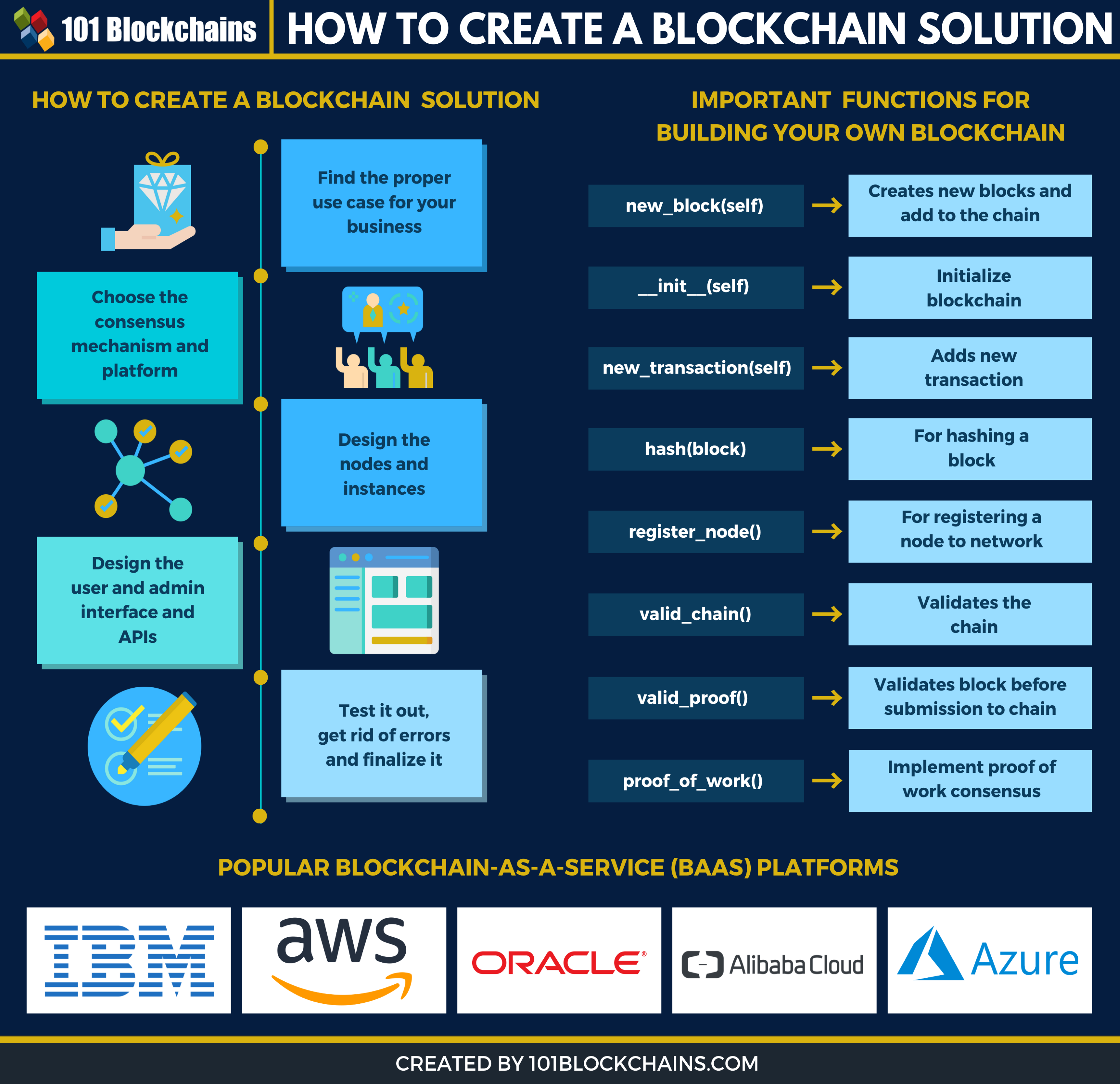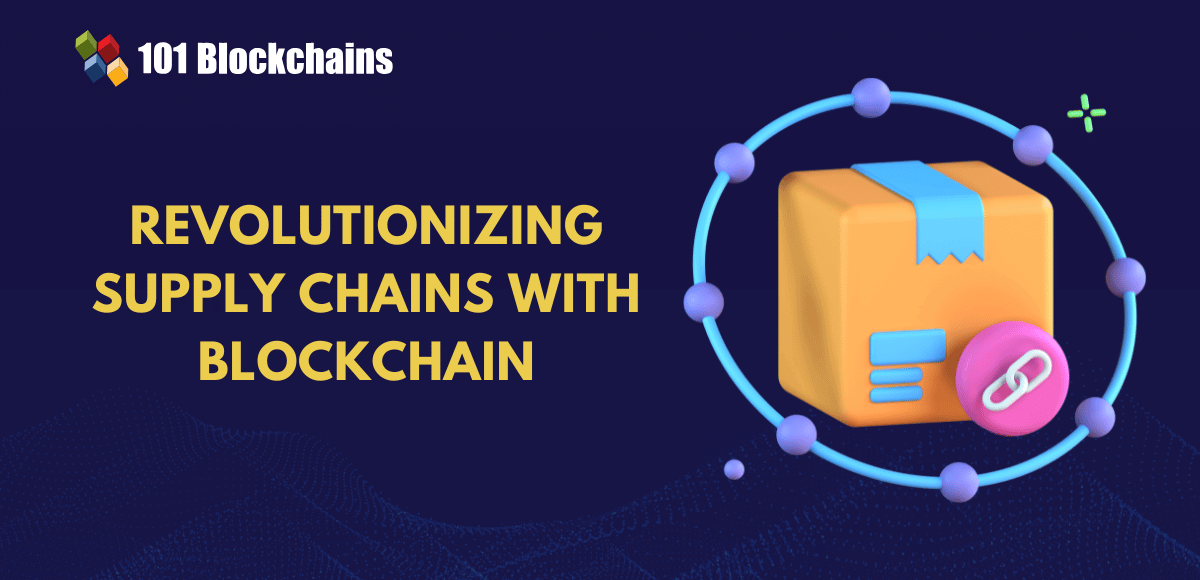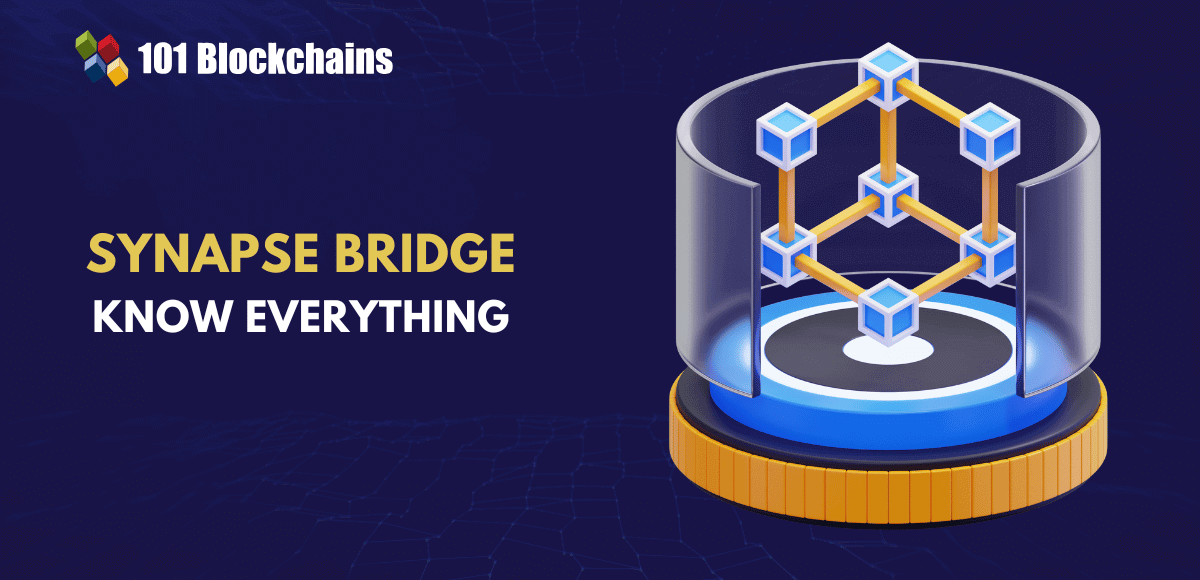Learn how blockchain truly works, master key definitions, and uncover what makes smart contracts so "smart." Dive into the fundamentals, gain valuable insights, and start your blockchain journey today!

- Blockchain
101 Blockchains
- on June 29, 2020
Learn How To Create A Blockchain
Have you ever wondered how to create a blockchain? If you do, then you have come to the right place.
Blockchains are the “future”. It has the potential to change everything around us and impact industries in an unprecedented way, just like how electricity and the internet changed our day-to-day lives.
Currently, blockchain is in initial stages where rapid development is taking place across the world to bring its adoption rate higher than ever. Some of the key players in the race include Hyperledger, Corda, and Ethereum. Each one of them is trying to solve the problem with a quest to improve blockchain adoption and implementation rate.
But, why are we saying all these things to you? That’s because we want to establish the fact that there is a demand for blockchain tools and solutions that actually works. This will also give you the motivation to create a blockchain application or a matter of fact, learn how to create your blockchain.
Build your identity as a certified blockchain expert with 101 Blockchains’ Blockchain Certifications designed to provide enhanced career prospects.
How to Create A Blockchain Application/ Solution From a Business Perspective
If you are a business person who is looking to learn how to create a blockchain solution, then we got you covered.
Let’s get started.
Step 1: Finding The Right Use-Case
Even though blockchain is promising and does what it’s intended to do, there is a lot of hype surrounding it. That’s why as a business, you need to understand the hype and clearly understand if blockchain in your case solves the problem. That’s why it is important to differentiate facts from hype and then make decisions based on it.
We have written a complete guide on when to choose blockchain where we discussed a step-by-step guide on how to do it. Check it out to learn when and where to use blockchain and determine whether blockchain is going to add anything to your business or not.
Generally, blockchain is best suited in the following cases:
- Smart asset management: If your business surrounds around exchange, retirement, issuance or payment, then you can use blockchain effectively as it requires you to do asset management
- Smart contracts: Smart contracts are a way to automate processes and also ensure legal bindings in digital code. If your business can make use of it, then it might be a good option to go with blockchain. But, before, you make the decision, it is better to introspect and make the right decision.
- Data Verification and Authentication: Blockchain also works seamlessly with digital signatures, immutable storage, and encryption. So, if you want to work with data that is generated using transactions then blockchain is a good choice.
Start learning Blockchain with the world’s first Blockchain Expert Career Path and become a Blockchain Expert!
Step 2: Choosing The Consensus Mechanism
The next step is to choose the consensus mechanism according to your requirement. There are many popular consensus mechanisms out there.
The most popular being Proof-of-Work(PoW). However, it is not ideal for business out there as it requires powerful hardware and a lot of energy to run successfully.
The good news is that there are plenty of other amazing consensus methods out there that are implemented in other distributed ledger systems(DLT) such as Corda, Hyperledger, Quorum, and others.
These DLTs offers consensus mechanisms such as Byzantine fault-tolerant, Proof of Stake, Federated Byzantine Agreement, Proof of Elapsed Time, Redundant Byzantine Fault Tolerance, Robin Round, Simplified Byzantine Fault Tolerance, Federated Consensus and so on!
Your job is to go through each of the available consensus mechanisms and figure out which one fits your requirements in the best possible way.
Step 3: Choosing the Platform
Now, you need to choose the platform on which you want to build your blockchain. Currently, there are multiple options available to you and all of them have to offer something unique. As a business, you need to find the platform that best suits your needs according to requirements and budget.
Some of the notable platforms that we recommend include Corda, Ethereum, Hyperledger Fabric, Hyperledger Sawtooth Lake, Hyperledger Iroha, Quorum, Stellar, OpenChain, BigChainDB, and others.
All of these platforms are extensively covered on 101Blockchains, and you can click on each one of them to know about them.
If you are an enterprise business, then you may want to check out Hyperledger Fabric.
Step 4: Nodes Design
With the consensus algorithm and platform selected, it is now time to design the nodes. In general, you can approach your blockchain network creation in many ways.
You can create a permissioned network which is a closed network and require strict KYC rules for nodes to join. On the other hand, there is a permissionless network which is essentially public networks. Here, anyone can join the network and take advantage of what it has to offer.
Most of the time, businesses require permissioned networks as they do not want to share vital information with everyone out there. Also, a permissioned network can be designed to share information with the public as well.
Once you have decided on it, you now need to decide where you run those nodes on. Do you want to run the nodes on the cloud or on-premise or a combination of both? Also, you need to come up with the hardware requirements where you decide memory, processors, and disk size for each node.
Lastly, you also need to design the operating system of the nodes. You can go with the free Linux operating systems such as CentOS, Fedora, Debian, or Ubuntu. If you are not comfortable with Linux-based OS, then you can also choose Windows as the operating system for your node.
Get familiar with the terms related to blockchain with Blockchain Basics Flashcards.
Step 5: Designing the Blockchain Instance
A blockchain instance is now required to be created. Creation and management is done based on the platform of your choice. Here, you can configure different aspects of the instance including the asset issuance, asset re-issuance, permissions, key management, atomic exchange, native assets, key formats, block signatures, and more!
This step is very crucial. That’s why you should take your proper time to design the blockchain instance.
Step 6: Application Programming Interface (APIs)
Now that you have your blockchain instance up and running, it is now time to manage the application programming interface(APIs). There are already pre-made APIs depending on the platform of your choice. This means that some platforms might not offer APIs at all.
So, why do you need API for? Well, you need them to do the following.
- Perform audit-related functions
- Generate key pairs and addresses
- Data retrieval and storage
- Data authentication using hashes and digital signature
- Smart contracts
- Managing the smart-asset lifecycle management which includes payment, issuance, escrow, exchange, and retirement
Step 7: Designing the User Interface And Admin
With the backend setup, it is now time for you to design the interface for the admin and the users. For the admin interface, you need to provide as much information as possible to the admin while making sure that you do not overwhelm the interface with unnecessary information.
For the user, you can decide to showcase the important things only. If you are in a permissioned network, you can decide to show them KYC information, their status with the network, their roles, and other vital information.
You can use any of the front end programming languages out there. We recommend choosing HTML5, CSS, C#, PHP, JavaScript, Java, and so on!
Step 8: Finalizing the Blockchain
The last step is to finalize the project. Here, you need to ensure that your blockchain network is running as intended by monitoring it non-stop. Also, make sure that you keep working on your blockchain network. You may also want to add future tech to your blockchain such as analytics, cloud, artificial intelligence, and so on!
Building your own Blockchain For Financial Product
In this section, we will cover important points about creating a blockchain for financial products. Financial products are different compared to other types of products and hence require different forms of planning and execution.
Infact, the financial sector is the most-ready industry out there that is ready for blockchain. Even the first use case for blockchain is a crypto-coin bitcoin which changes how two parties connect and transfer funds to each other.
FinTech is one of those sectors that always suffer from some sort of fraud or foul play. This is because of the fact that people are willing to do the wrong things just to make more money. And, that’s where blockchain comes in as it provides the necessary means to protect the interest of all the parties out there.
By using blockchain, parties can work without any intermediaries and hence can save energy and cost associated with doing the transaction. Blockchain is also useful when it comes to managing other aspects of the business including trading goods, logistics & inventory, tracking transactions, and so on.
But, not every fintech product should adopt blockchain so early. Below are the reasons why you should try to invest in the blockchain:
- Attract investments: Blockchain adoption is now seen as forward-looking and hence can work amazingly if you are looking for investments.
- Increased competitiveness: If you adopt blockchain early, you will surely set forth competition in the market.
- Experimentation: If you are looking for experimentation then blockchain-based product development can be a great move. You can also be one of the first fintech products to make a breakthrough.
When Blockchain Is Not A Good Option For Financial Products?
There are of course many cases where blockchain is not a good option. For example, if you are limited in your resources, then it is not wise to go for blockchain. Blockchain engineers are not cheap and it also takes a lot of effort to maintain the blockchain.
Also, a blockchain implementation means a lot of changes to how operations work, and that could be too much for employees or the end-users who interact with the system.
Lastly, it is not advisable where your Fintech product is looking for short-term goals. Blockchain, due to its implementation difficulty and cost involved, makes it always a long-term strategy for any business out there.
Blockchain Frameworks applicable in Fintech
Fintech can benefit from the following frameworks
- Ethereum → It is a popular open-source framework for building decentralized applications.
- CryptoNote → Another popular open-source project where you can create crypto coins.
- ZeroNet → An interesting platform where you can create decentralized websites.
I want to actually build a blockchain! Show me how to do create a blockchain
Well, if you are someone who wants to get into the nitty-gritty of creating your own blockchain, then this section is for you.
The good news is that we have already written a complete tutorial on how to build a blockchain in Python.
Check out the infographic we created to give you a glimpse of what you can expect from the tutorial.
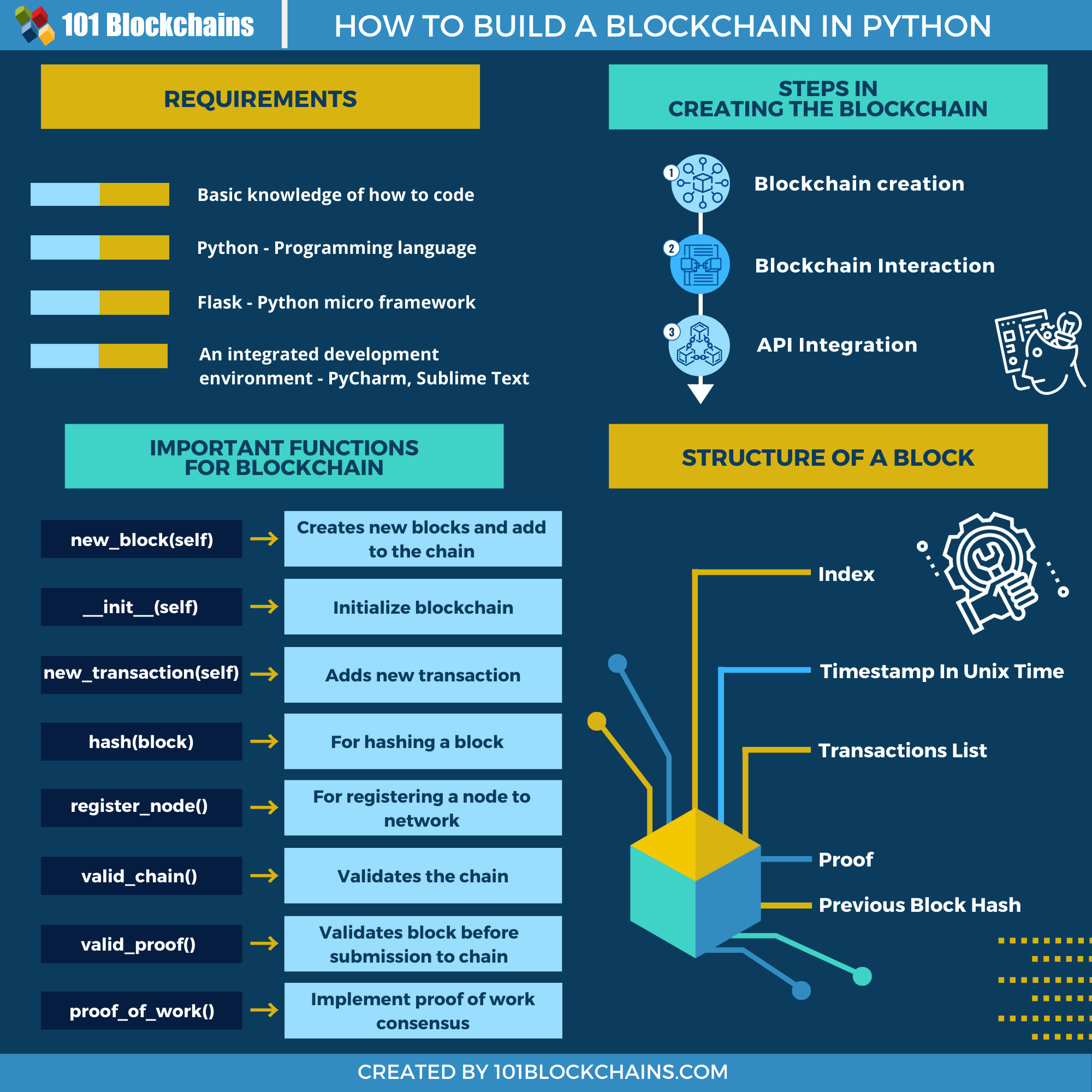
So, what do you need to get started? Well, if you have some programming experience, then you can follow the tutorial. If you do not have any prior programming experience, then you can find tons of tutorials online where you can learn how to code.
We recommend you start with Python Documentation. Moreover, you also need to learn Flask — a Python micro-framework.
To gist the whole development process, you need to create a block with five key variables.
- Index
- Timestamp in Unix time
- Transaction List
- Proof
- Previous Block Hash
Also, the important function that you need to create in your blockchain include
- new_block(self) → Here, you need to create new blocks and then add it to the chain
- __init__(self) → Here, you initialize the blockchain
- new_transactions(self) → Create and add new transactions
- hash(block) → Here, a block is hashed
- register_node() → Here, a new node is registered
- valid_chain() → Validation of the chain happens here
- valid_proof() → the validation proof takes place before it is submitted to chain
- proof_of_work() → Here, the proof of work consensus is implemented
Popular Blockchain-as-a-service(BaaS) Platforms
There are also popular Blockchain-as-a-Service(BaaS) platforms out there. These BaaS platforms are third-party and help you to manage and create blockchain networks. It is a cloud-based solution where companies provide the necessary tools and infrastructure to host blockchain networks.
These BaaS are very useful for businesses as it gives them the ability to create new blockchain networks and apps on it without the need to create the infrastructure for them. They also do not have to spend on maintenance for these deployments as the company offering the service does all those stuff.
So, which BaaS platforms should you consider? Let’s list them below.
- Amazon Web Services
- IBM Blockchain Platform
- Microsoft Azure
- Alibaba Cloud Blockchain as a Service
- Oracle Blockchain Cloud Service
Also read, AWS vs AZURE vs Oracle Blockchain Solution Offering: Comparison
We already covered in detail on how to choose the right BaaS platform for your business. Check out the infographic below to get a good glimpse of what to expect.
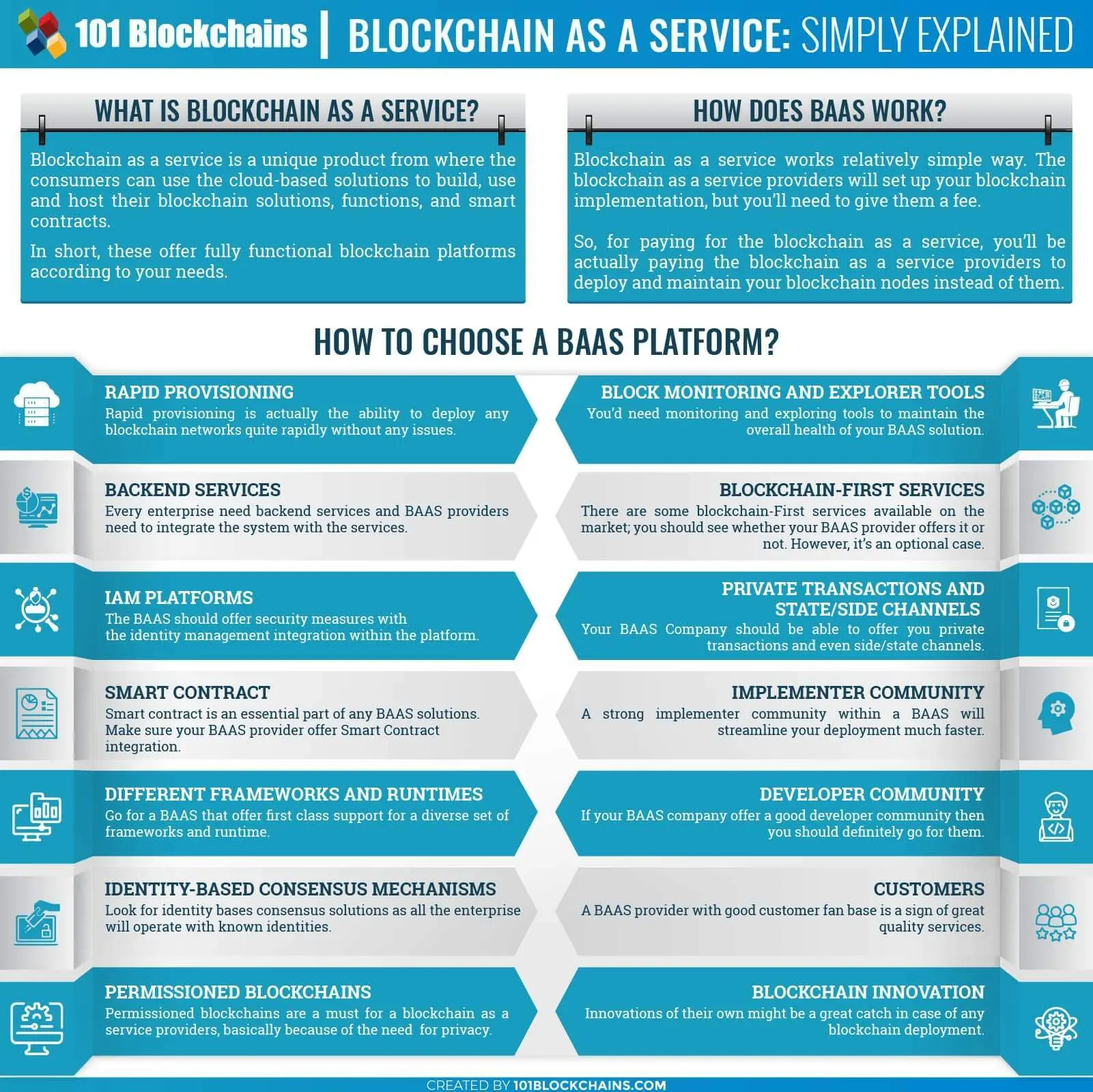
If you want to read more about it, you can check out it here: Blockchain as a Service: Enterprise-Grade BaaS Solutions.
Becoming A Blockchain Developer
We know that if you are reading this article, you are either a business or an aspiring learner who wants to become a blockchain developer.
The good news is that we already covered a plethora of blockchain developer content on our site. Check them out below.
- 30+ Blockchain Developer Interview Questions in 2020
- Blockchain Developer Salary On The Rise
- How To Land A Blockchain Developer Job
Conclusion
This leads us to the end of how to create a blockchain article. We covered quite a bit of content and tried to look at the question from both the learner or a business perspective. So, what do you think about creating your own blockchain? Comment below and let us know.

